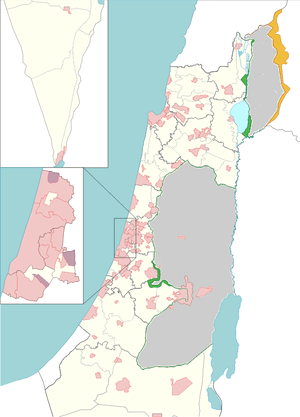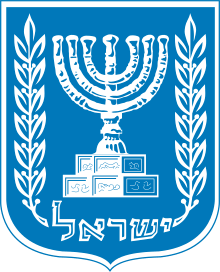List of cities in Israel
This list includes cities that are in Israel and Israeli settlements with city status in the occupied West Bank; Jerusalem includes occupied East Jerusalem. The list is based on the current index of the Israel Central Bureau of Statistics (CBS). Within Israel's system of local government, an urban municipality can be granted a city council by the Israeli Interior Ministry when its population exceeds 20,000.[1] The term "city" does not generally refer to local councils or urban agglomerations, even though a defined city often contains only a small portion of an urban area or metropolitan area's population.
List
Israel
Israel has 15 cities with populations over 100,000, including Jerusalem at over 500,000 (including occupied East Jerusalem), and Tel Aviv.[2] In all, there are 76 Israeli municipalities granted "city" status by the Ministry of the Interior. Two more cities are planned: Kasif, a planned city to be built in the Negev, and Harish, originally a small town currently being built into a large city. The area and population of Jerusalem includes that of East Jerusalem which has been de facto annexed by Israel and incorporated within Jerusalem's municipal borders under the Jerusalem Law. This, however, is not recognized by the international community who regard East Jerusalem as part of the Occupied Palestinian Territory.[3][4]
The following table lists all Israeli cities by name, district, population, and area, according to the Israel Central Bureau of Statistics:
| Name | First settlement |
Photo | District | Population estimate, 2017[5] |
Population census, 2008[6] |
Change, 2008– –2017 |
Area, km² [7] |
Density, per km² [8] |
Socio- economic index[9] |
|---|---|---|---|---|---|---|---|---|---|
| Acre[cbs 1] | Bronze Age | 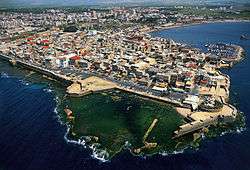 |
North | 48,303 | 46,100 | +4.78% | 13.5 | 3,362.0 | −0.395 |
| Afula | Bronze Age | 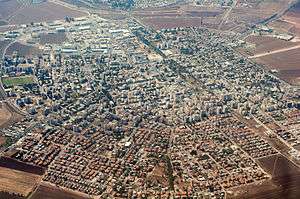 |
North | 49,169 | 40,200 | +22.31% | 26.9 | 1,611.7 | −0.028 |
| Arad | 1962 | South | 25,530 | 23,400 | +9.10% | 93.1 | 195.9 | 0.287 | |
| Ashdod | Bronze Age | South | 222,883 | 204,300 | +9.10% | 47.2 | 4,783.9 | −0.109 | |
| Ashkelon[cbs 2] | Neolithic | 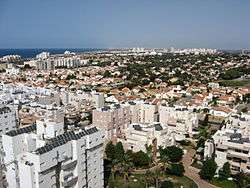 |
South | 137,945 | 110,600 | +24.72% | 47.8 | 2,964.8 | -0.032 |
| Baqa al-Gharbiyye | Middle Ages | 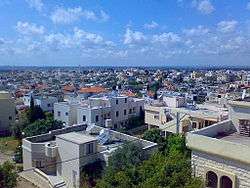 |
Haifa | 29,035 | N/A | N/A | 16.4 | 3,152.1 | −0.736 |
| Bat Yam | 1926 |  |
Tel Aviv | 128,655 | 130,300 | −1.26% | 8.2 | 15,758.4 | −0.025 |
| Beersheba[cbs 3] | 1900[note 1] | South | 207,551 | 193,400 | +7.32% | 117.5 | 1,751.7 | 0.035 | |
| Beit She'an[cbs 4] | Neolithic |  |
North | 17,704 | 16,900 | +4.76% | 7.3 | 2,379.9 | −0.277 |
| Beit Shemesh[cbs 5] | 1950 |  |
Jerusalem | 114,371 | 72,700 | +57.32% | 34.3 | 2,866.6 | −1.149 |
| Bnei Brak[cbs 6] | 1924 |  |
Tel Aviv | 193,774 | 151,800 | +27.65% | 7.1 | 25,709.4 | −1.304 |
| Dimona | 1955 | South | 33,666 | 32,400 | +3.91% | 29.9 | 193.7 | −0.235 | |
| Eilat[cbs 7] | Neolithic |  |
South | 50,724 | 47,300 | +7.24% | 84.8 | 509.6 | 0.247 |
| El'ad | 1998 | Center | 46,896 | 33,900 | +38.34% | 2.8 | 13,138.6 | −1.493 | |
| Giv'at Shmuel[cbs 8] | 1944 |  |
Center | 25,776 | 21,000 | +22.74% | 2.6 | 9,978.1 | 1.124 |
| Givatayim[cbs 9] | 1922 | .jpg) |
Tel Aviv | 59,518 | 52,100 | +14.24% | 3.3 | 18,058.2 | 1.417 |
| Hadera | 1891 | 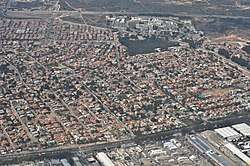 |
Haifa | 93,973 | 79,400 | +18.35% | 49.4 | 1,809.2 | 0.255 |
| Haifa | Antiquity | 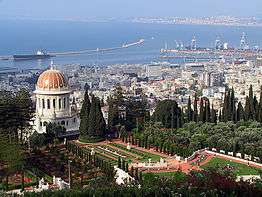 |
Haifa | 281,087 | 264,300 | +6.35% | 63.7 | 4,331.4 | 0.652 |
| Herzliya[cbs 10] | 1924 |  |
Tel Aviv | 93,989 | 86,300 | +8.91% | 21.6 | 4,291.0 | 1.373 |
| Hod HaSharon | 1924 | Center | 61,102 | 46,300 | +31.97% | 21.6 | 3,058.9 | 1.485 | |
| Holon | 1935 |  |
Tel Aviv | 192,624 | 176,300 | +9.26% | 18.9 | 10,017.7 | 0.509 |
| Jerusalem | Neolithic | -Aerial-Jerusalem-Temple_Mount-Temple_Mount_(south_exposure).jpg) |
Jerusalem | 901,302 | 759,700 | +18.64% | 125.2 | 7,014.1 | −0.802 |
| Kafr Qasim[cbs 11] | 19th century |  |
Center | 22,743 | 18,400 | +23.60% | 8.7 | 2,391.5 | −0.841 |
| Karmiel[cbs 12] | 1964 |  |
North | 45,919 | 44,200 | +3.89% | 19.2 | 2,056.3 | 0.309 |
| Kfar Saba[cbs 13] | 1903 | Center | 100,039 | 82,800 | +20.82% | 14.2 | 6,831.0 | 1.191 | |
| Kfar Yona[cbs 14] | 1932 | 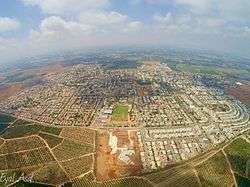 |
Center | 22,537 | 16,500 | +36.59% | 11.0 | 1,962.4 | 0.786 |
| Kiryat Ata[cbs 15] | 1925 |  |
Haifa | 57,518 | 50,400 | +14.12% | 16.7 | 3,253.0 | 0.249 |
| Kiryat Bialik[cbs 16] | 1934 |  |
Haifa | 39,582 | 37,200 | +6.40% | 8.2 | 4,650.1 | 0.567 |
| Kiryat Gat[cbs 17] | 1954 |  |
South | 53,487 | 47,500 | +12.60% | 16.3 | 3,328.2 | −0.378 |
| Kiryat Malakhi[cbs 18] | 1950 |  |
South | 22,337 | 20,500 | +8.96% | 4.6 | 4,741.2 | −0.594 |
| Kiryat Motzkin[cbs 19] | 1934 | 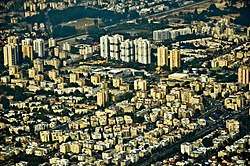 |
Haifa | 41,440 | 38,100 | +8.77% | 3.8 | 10,612.0 | 0.590 |
| Kiryat Ono[cbs 20] | 1939 | 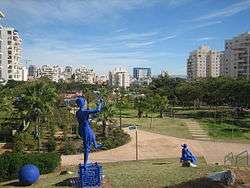 |
Tel Aviv | 39,398 | 30,000 | +31.33% | 4.1 | 8,557.8 | 1.513 |
| Kiryat Shmona[cbs 21] | 1949 | North | 22,844 | 23,200 | −1.53% | 14.2 | 1,595.8 | −0.014 | |
| Kiryat Yam[cbs 22] | 1941 | 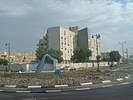 |
Haifa | 39,710 | 37,700 | +5.33% | 4.3 | 8,568.6 | 0.018 |
| Lod | Neolithic | Center | 74,604 | 69,400 | +7.50% | 12.2 | 6,078.3 | −0.448 | |
| Ma'alot-Tarshiha | 1963 | North | 21,267 | 20,600 | +3.24% | 6.8 | 2,303.0 | 0.024 | |
| Migdal HaEmek[cbs 23] | 1953 | North | 25,371 | 23,900 | +6.15% | 7.6 | 2,876.6 | −0.273 | |
| Modi'in-Maccabim-Re'ut [cbs 24] |
1985 | Center | 91,328 | 69,300 | +31.79% | 50.2 | 1,862.5 | 1.351 | |
| Nahariya[cbs 25] | 1935 |  |
North | 56,071 | 51,300 | +9.30% | 10.2 | 4,941.8 | 0.436 |
| Nazareth | Bronze Age |  |
North | 76,551 | 71,700 | +6.77% | 14.1 | 5,357.9 | −0.558 |
| Nazareth Illit[cbs 26] | 1957 | 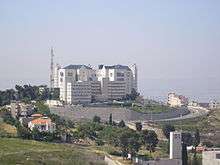 |
North | 40,596 | 41,400 | −1.94% | 32.5 | 1,224.4 | 0.055 |
| Nesher | 1923 | Haifa | 23,749 | 23,300 | +1.93% | 12.8 | 1,828.9 | 0.783 | |
| Ness Ziona[cbs 27] | 1883 |  |
Center | 49,108 | 36,100 | +36.03% | 15.6 | 3,071.5 | 1.265 |
| Netanya | 1929 | 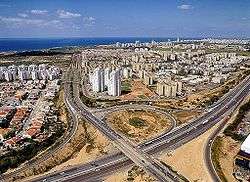 |
Center | 214,101 | 180,100 | +18.88% | 29.0 | 6,807.7 | 0.240 |
| Netivot | 1956 | .jpg) |
South | 33,779 | 26,100 | +29.42% | 5.6 | 2,874.7 | −0.760 |
| Ofakim[cbs 28] | 1955 |  |
South | 27,771 | 24,000 | +15.71% | 10.3 | 2,565.0 | −0.757 |
| Or Akiva[cbs 29] | 1951 | .jpg) |
Haifa | 17,759 | 16,000 | +10.99% | 3.5 | 3,165.3 | −0.097 |
| Or Yehuda | 1955 | Tel Aviv | 36,706 | 33,900 | +8.28% | 5.1 | 5,477.7 | 0.133 | |
| Petah Tikva[cbs 30] | 1878 | 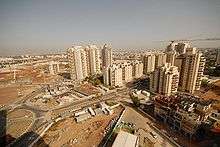 |
Center | 240,357 | 200,300 | +20.00% | 35.9 | 6,626.5 | 0.655 |
| Qalansawe | Middle Ages | 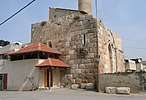 |
Center | 22,370 | 18,200 | +22.91% | 8.4 | 2,603.2 | −1.011 |
| Ra'anana[cbs 31] | 1922 | Center | 72,810 | 68,300 | +6.60% | 14.9 | 4,833.8 | 1.462 | |
| Rahat | 1972 |  |
South | 66,791 | 50,000 | +33.58% | 19.6 | 3,283.9 | −1.848 |
| Ramat Gan | 1921 |  |
Tel Aviv | 156,277 | 143,600 | +8.83% | 13.2 | 9,376.1 | 1.041 |
| Ramat HaSharon | 1923 | Tel Aviv | 46,019 | 39,000 | +18.00% | 16.8 | 2,708.3 | 1.796 | |
| Ramla | 8th century |  |
Center | 75,668 | 65,700 | +15.17% | 11.9 | 6,252.2 | −0.333 |
| Rehovot | 1890 | Center | 138,379 | 111,100 | +24.55% | 23.0 | 5,712.4 | 0.629 | |
| Rishon LeZion[cbs 32] | 1882 | 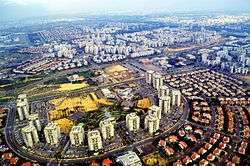 |
Center | 249,860 | 226,800 | +10.17% | 58.7 | 4,212.6 | 0.886 |
| Rosh HaAyin | 1949 | 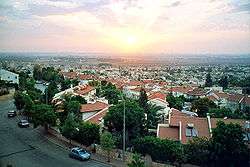 |
Center | 50,453 | 37,900 | +33.12% | 24.4 | 2,868.0 | 0.578 |
| Safed[cbs 33] | Bronze Age | 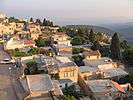 |
North | 35,276 | 29,600 | +19.18% | 29.2 | 1,123.5 | −1.011 |
| Sakhnin | Bronze Age | North | 30,548 | 25,100 | +21.71% | 9.8 | 3,062.2 | −0.740 | |
| Sderot[cbs 34] | 1951 |  |
South | 25,138 | 20,700 | +21.44% | 4.5 | 3,788.0 | −0.223 |
| Shefa-'Amr[cbs 35] | Bronze Age | North | 41,024 | 35,700 | +14.91% | 19.8 | 2,065.0 | −0.784 | |
| Tamra | N/A |  |
North | 33,380 | 28,100 | +18.79% | 29.3 | 1,118.1 | −0.983 |
| Tayibe | N/A |  |
Center | 42,401 | 35,700 | +18.77% | 18.7 | 2,198.7 | −0.878 |
| Tel Aviv[cbs 36] | Bronze Age (Jaffa) |
.jpg) |
Tel Aviv | 443,939 | 402,600 | +10.27% | 51.8 | 8,473.0 | 1.221 |
| Tiberias | 20 | .jpg) |
North | 43,664 | 41,600 | +4.96% | 10.9 | 2,663.5 | −0.379 |
| Tira[cbs 37] | N/A | .jpg) |
Center | 25,721 | 22,200 | +15.86% | 11.9 | 2,128.7 | −0.469 |
| Tirat Carmel[cbs 38] | N/A |  |
Haifa | 21,256 | 18,600 | +14.28% | 5.6 | 3,425.4 | −0.138 |
| Umm al-Fahm | N/A |  |
Haifa | 54,240 | 45,000 | +20.53% | 22.3 | 2,053.4 | −1.294 |
| Yavne | Bronze Age | Center | 45,483 | 32,800 | +38.67% | 10.7 | 2,690.9 | 0.455 | |
| Yehud-Monosson | N/A |  |
Center | 29,689 | 26,200 | +13.32% | 5.0 | 5,862.3 | 1.034 |
| Yokneam Illit[cbs 39] | 1950 | 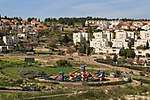 |
North | 22,746 | 19,000 | +19.72% | 7.4 | 2,649.1 | 0.800 |
West Bank
Four Israeli settlements in the West Bank, an area outside of sovereign Israeli territory, have been given city status by the Israeli Ministry of the Interior. The United Nations Security Council,[10] the United Nations General Assembly,[11] the International Court of Justice,[12] and the International Committee of the Red Cross[13] refer to it as Occupied Palestinian Territory. All of these settlements are part of the Judea and Samaria Area district, the formal district name for the entirety of the West Bank, excluding East Jerusalem. The international community considers Israeli settlements illegal under international law, but the Israeli government disputes this.[14]
| Name | First settlement |
Photo | Population estimate, 2017[5] |
Population census, 2008[15] |
Change, 2008– –2017 |
Area, km² [16] |
Density, per km² [17] |
Socio- economic index[18] |
|---|---|---|---|---|---|---|---|---|
| Ariel[cbs 40] | 1978 | 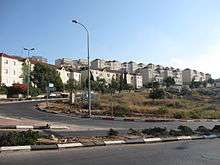 |
19,626 | 17,500 | +12.15% | 14.7 | 1,307.5 | 0.378 |
| Beitar Illit[cbs 41] | 1985 | 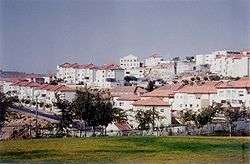 |
54,557 | 32,900 | +65.83% | 6.8 | 7,593.5 | −1.950 |
| Ma'ale Adumim[cbs 42] | 1975 |  |
37,817 | 33,600 | +12.55% | 49.2 | 765.7 | 0.298 |
| Modi'in Illit | 1994 | 70,081 | 40,800 | +71.77% | 4.7 | 16,837.9 | −2.075 |
See also
- Arab localities in Israel
- Chronology of Aliyah in modern times
- City council (Israel)
- Demographics of Israel
- Districts of Israel
- Four Holy Cities
- Largest metropolitan areas of the Middle East
- List of cities administered by the Palestinian Authority
- List of cities of the ancient Near East
- List of Israeli settlements with city status in the West Bank
- List of Israeli twin towns and sister cities
- List of kibbutzim
- List of modern names for biblical place names
- List of moshavim shitufiim
- List of urban areas by Jewish population
- List of villages depopulated during the Arab–Israeli conflict
- Lists of cities by country
- Population displacements in Israel after 1948
- Population statistics for Israeli Gaza Strip settlements
- Population statistics for Israeli settlements in the West Bank
Notes
- General
- ↑ Tel Be'er Sheva, remains of the ancient town, lies east of the modern city.
- Official spellings
- ↑ Akko
- ↑ Ashqelon
- ↑ Be'er Sheva
- ↑ Bet She'an
- ↑ Bet Shemesh
- ↑ Bene Beraq
- ↑ Elat
- ↑ Giv'at Shemu'el
- ↑ Giv'atayim
- ↑ Herzliyya
- ↑ Kafar Qasem
- ↑ Karmi'el
- ↑ Kefar Sava
- ↑ Kefar Yona
- ↑ Qiryat Atta
- ↑ Qiryat Bialik
- ↑ Qiryat Gat
- ↑ Qiryat Mal'akhi
- ↑ Qiryat Motzkin
- ↑ Qiryat Ono
- ↑ Qiryat Shemona
- ↑ Qiryat Yam
- ↑ Migdal HaEmeq
- ↑ Modi'in-Makkabbim-Re'ut
- ↑ Nahariyya
- ↑ Nazerat Illit
- ↑ Nes Ziyyona
- ↑ Ofaqim
- ↑ Or Aqiva
- ↑ Petah Tiqwa
- ↑ Ra'annana
- ↑ Rishon LeZiyyon
- ↑ Zefat
- ↑ Sederot
- ↑ Shefar'am
- ↑ Tel Aviv-Yafo
- ↑ Tire
- ↑ Tirat Karmel
- ↑ Yoqne'am Illit
- ↑ Ari'el
- ↑ Betar Illit
- ↑ Ma'ale Adummim
References
- ↑ "Israeli Democracy: How Does It Work?". Israel Ministry of Foreign Affairs. Archived from the original on 22 June 2013. Retrieved 8 May 2013.
- ↑ "Inventory of World Cities". Globalization and World Cities Study Group & Network. Archived from the original on 14 October 2013. Retrieved 2008-04-11.
- ↑ Symon, Fiona (4 December 2001). "Jerusalem: Crucible of the conflict". BBC News Online. Retrieved 11 October 2012.
- ↑ "Background on East Jerusalem". B'Tselem. 8 July 2012. Retrieved 11 October 2012.
- 1 2 "List of localities, in Alphabetical order" (PDF). Israel Central Bureau of Statistics. Retrieved August 26, 2018.
- ↑ "Profiles by Locality". Israel Central Bureau of Statistics. 2008. Retrieved 2 May 2015.
- ↑ "2004 local government profile" (in Hebrew). Israel Central Bureau of Statistics. Retrieved 2007-08-17.
- ↑ Population and Density per Sq. Km. in Localities Numbering 5,000 Residents and More on 31.12.2016 (Report). Israel Central Bureau of Statistics. 6 September 2017. Retrieved 12 January 2018.
- ↑ SOCIO-ECONOMIC INDEX 2013 OF LOCAL AUTHORITIES, IN ALPHABETICAL ORDER OF HEBREW NAMES (PDF) (Report). Israel Central Bureau of Statistics. Retrieved 12 January 2018.
- ↑ Resolution 446, Resolution 465, Resolution 484, among others
- ↑ "Applicability of the Geneva Convention relative to the Protection of Civilian Persons in Time of War, of 12 August 1949, to the Occupied Palestinian Territory, including Jerusalem, and the other occupied Arab territories". United Nations. December 17, 2003. Archived from the original on 3 June 2007. Retrieved 2006-09-27.
- ↑ "Legal Consequences of the Construction of a Wall in the Occupied Palestinian Territory". International Court of Justice. July 9, 2004. Archived from the original on 28 August 2007. Retrieved 2006-09-27.
- ↑ "Implementation of the Fourth Geneva Convention in the occupied Palestinian territories: history of a multilateral process (1997-2001)". International Review of the Red Cross. International Committee of the Red Cross. 30 September 2002. Archived from the original on 7 February 2011. Retrieved 11 October 2012.
- ↑ "The Geneva Convention". BBC. 2009-12-10.
- ↑ "Profiles by Locality". Israel Central Bureau of Statistics. 2008. Retrieved 2 May 2015.
- ↑ "2004 local government profile" (in Hebrew). Israel Central Bureau of Statistics. Retrieved 2007-08-17.
- ↑ Population and Density per Sq. Km. in Localities Numbering 5,000 Residents and More on 31.12.2016 (Report). Israel Central Bureau of Statistics. 6 September 2017. Retrieved 12 January 2018.
- ↑ SOCIO-ECONOMIC INDEX 2013 OF LOCAL AUTHORITIES, IN ALPHABETICAL ORDER OF HEBREW NAMES (PDF) (Report). Israel Central Bureau of Statistics. Retrieved 12 January 2018.
External links
| Wikimedia Commons has media related to Cities in Israel. |
- Cities and Communities in Israel at the Israel Ministry of Tourism
- List of cities and towns in Israel at Encyclopædia Britannica
- Geography of Israel at the Jewish Virtual Library
- Localities Numbering 5,000 Residents and More at the Israel Central Bureau of Statistics
- Localities of Israel at Curlie (based on DMOZ)
